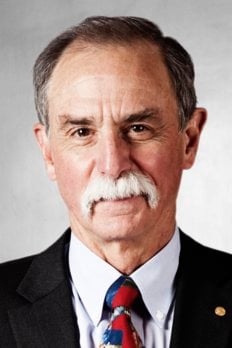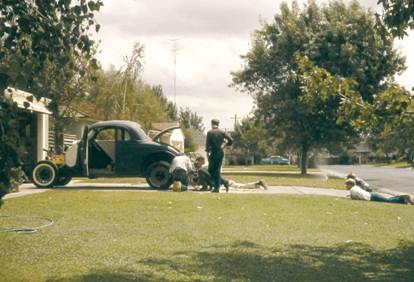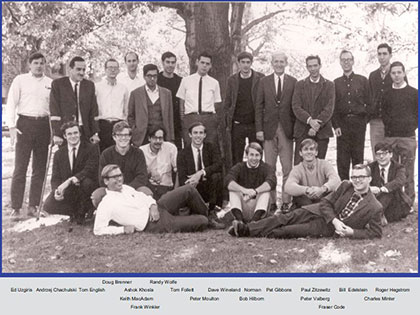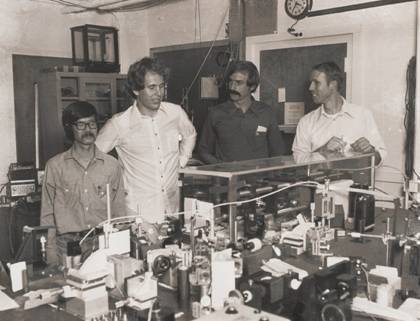David J. Wineland
Biographical

I was born in Wauwatosa, Wisconsin – just outside Milwaukee – in February 1944, two years after my sister Judy. My parents were born in the U.S. in 1903 and 1905; they both had independent careers until my sister was born; then my mother stayed at home to be with my sister and me. My father received an engineering degree from Cal Tech in 1931. He and my mother moved around quite often during the war; at that time my father was working for Allis Chalmers on jet engines. At the end of the war, we moved to Denver, where he returned to a job with the Bureau of Reclamation as a civil engineer. Shortly after that, in 1947 we moved to Sacramento, California where my sister and I grew up and my father spent the remainder of his career.
Growing up, I was always fascinated by mechanical things, particularly anything that had an engine in it. As a kid, this took the form of model airplanes, stimulated by the fact that we lived very near a major Air Force base that was filled with many airplanes from the war, which my friends and I could explore with little restriction. I also liked math from an early age; my father would play simple games like adding, multiplying, etc. in rapid succession – something I could beat my sister at! My parents were definitely products of the great depression; they emphasized the importance of frugality and getting a good education, which could enhance the prospects of finding a good job later on. So, from an early age I knew I was destined to go to college and I always kept up my grades to be able to do that. As a senior in high school, I took my first physics class. I immediately liked the idea that relatively simple mathematics could explain many of the things we see in the world. But at that time I didn’t really jump in; my passion then was cars and motorcycles. With the permission of my father, I bought my first car at 14, a year and a half before I could have a driver’s license, but it gave me time to take it apart and fix it up. Of course, this was partly social; my buddies and I all loved cars and motorcycles and having those close friends with a common interest was a great part of growing up.
After high school, in 1961, I attended the University of California, Davis, in part because of the prestige of the University of California and because Davis is fairly near to Sacramento. I started as a math major and was a bit unsure how I would measure up, but about half way through the first semester I realized that if I worked hard I could be near the top of my class. I now regret that I was too much motivated by achieving high grades, which meant I spent a disproportionate amount of time on subjects in the humanities that were difficult for me, rather than just enjoying those classes and getting B’s. The math and physics came much more naturally.
At that time, Davis was still emerging from being primarily an agricultural school, so in my junior year I transferred to the Berkeley campus as a physics major – to be at the big time! Berkeley was a frightening, impersonal place to me at the time, but I loved it and the challenge it presented. Out of fear of not making good grades, I didn’t become involved in research, so when I graduated, I still had no real idea of what experimental physics was like. My classical mechanics teacher at Berkeley, Fredrick Byron, had a great influence on me. His class was probably the most difficult one I took at Berkeley, but he had the knack of making us want to do the work. Because I respected him so much, I asked him about places to apply for graduate school. He recommended Harvard, so I applied there (and to Berkeley as insurance, because that would have been fine and I was pretty sure I would be accepted there).

In 1965, I started graduate school in physics at Harvard in a class of 26. Because of Harvard’s reputation, I remember thinking uh-oh, 25 geniuses and me! In the end I think there were maybe a couple of geniuses, but the rest were like me, pretty ordinary, but motivated to do well. As much as I still liked how mathematics and physics combined so well together, I was beginning to see that theoretical physics was not for me, so I started to think about experiments. At that time, it appeared to me that the real excitement was in particle physics; it seemed that a new particle was being discovered every other week. The excitement was palpable and it was natural to look in that direction. What frightened me was the prospect of getting buried in a large group and not finding a way to distinguish myself – good or bad. From looking at the low energy experimental groups, it was evident that I would probably be able to have my own experiment if I went that direction. There were several very good low energy experimental groups at Harvard, but in the end I asked to join Norman Ramsey‘s group. Ramsey, with his close colleague Dan Kleppner and student Mark Goldenberg had recently invented and demonstrated the first hydrogen masers. I was attracted to the idea of precision measurements and a not-insignificant factor was that Ramsey had the reputation of being a very nice person. After the initial results on hydrogen, Ramsey wanted to make precise measurements of the hyperfine frequencies of all three isotopes of hydrogen, so I chose to work on deuterium. The experiment was relatively straightforward, complicated a bit by the relatively long wavelength (~ 92 cm) of deuterium’s hyperfine transition relative to that of hydrogen (~ 21 cm).

During that time, Ramsey served as president of the University Research Association, which managed the construction and operation of Fermilab in Batavia, Illinois. Therefore, he was away from Harvard much of the time. As a consequence, most of us graduate students would help each other along and I liked that experience very much. However, since we were left alone, it sometimes took a while for us to figure out when we made a wrong turn in our projects. In spite of Ramsey’s commitments at Fermilab, he would nearly always make a point to return to Harvard for our weekly group meetings. Moreover, whether or not it was deserved, he always supported us and offered encouragement. Ramsey had a very intuitive approach to physics, and was able to make simple pictures that explained the essence of the physics without getting bogged down in mathematical complexity; a lot of the physics we explored could be explained by mapping the problem onto that of a spin-1/2 magnetic dipole in a magnetic field. By the time I finished graduate school, I was hooked on highresolution spectroscopy and precision measurements. However, I still wasn’t completely immersed in physics and took many Sundays in graduate school and as a postdoc to realize a long-term dream of racing motorcycles. I had a lot of fun with it but it was clear it was not a way of the future for me.
During the time I was a graduate student, I read about the precision 3He+ hyperfine spectroscopy and electron g-factor measurements of Hans Dehmelt and his colleagues at the University of Washington in Seattle. I was very attracted to ion spectroscopy, but I joined the group to work on Dehmelt’s electron magnetic moment experiment. Fred Walls had started the electron experiment as a graduate student with Dehmelt and would later become a colleague at the National Bureau of Standards (NBS). After a while working on the experiment, it became clear that systematic shifts would be smallest for a single trapped electron, so obtaining that goal was my primary project while at Seattle. Dehmelt also had great intuition and was able to reduce all problems to simple semi-classical pictures. Similar to Ramsey, it seemed he could map nearly all problems onto a tuned circuit. I’ve tried my best to copy their intuitive approach and many times it has served me well. During my tenure at the University of Washington, I met and married my wife, Sedna. Her father, George Quimby, was an anthropologist and director of the Burke Museum, so she was used to and understood long hours spent at work. Her support of this has always been extremely important to me. We have two sons, Charles and Michael; neither are physicists – probably one in the family is enough! In Seattle, I also became good friends with fellow postdoc Bob Van Dyck, who later took a faculty position there and was the key person on the electron magnetic moment experiment. When I began looking for a permanent job, I had my heart set on finding an academic position. However, after about a year of looking, it became clear that the academic positions offered to me would not be able to provide sufficient funds to start a viable experimental program.
Fortunately, a position opened in the Time and Frequency Division of NBS in Boulder, Colorado, and with my background and interest in clocks, I was more than pleased to find a home there. When I arrived, NBS did not have an operating accurate Cesium beam clock, so there was some urgency to achieve this. David Glaze from the division had built the newest version of the Cesium beam clock, NBS-6, and he and I worked to calibrate the device and produce the unit of time, the second. This took about a year and a half. At that time, the Time and Frequency Division had very little research activity. Fortunately my boss, Helmut Hellwig, had a vision that the Division should be doing more basic research and prior to my being hired, he had hired Fred Walls, who had spent a postdoc at JILA, to start research on hydrogen masers. After the Cesium frequency standard was made operational, Helmut was able to get some internal support to start an experiment on laser cooling. Bob Drullinger, who had experience with dye lasers, joined in the project, and with my and Fred Walls’ experience with ion traps, we were off and running. This was a very exciting time for me, because it was a project of our own choosing, and it would be great to realize an earlier idea of laser cooling that I had developed with Dehmelt. We started with an empty lab in the summer of 1977, but by the spring of 1978 we had our first results. I knew that we had competition because I was aware that Dehmelt had taken a sabbatical to work in Peter Toschek’s lab in Heidelberg, with the same goal of demonstrating cooling. I didn’t know at what stage they were at in their experiment and I don’t believe they were aware of our experiment. Our paper was published a bit earlier than theirs, but in a near coincidence – even with no contact between the groups – our papers were received at Physical Review Letters within a day of each other (the Toschek group beat us by one day!).
Bob Drullinger and I were subsequently joined by Wayne Itano and Jim Bergquist on these projects and few years later by John Bollinger. We have spent nearly our entire careers working together or on closely related projects. This has been a great experience for me because they have been such great colleagues as well as friends. One of the primary and continuing goals our work has been to make better atomic clocks, and laser cooling has been important to suppress relativistic time dilation in these experiments. In 1985 we demonstrated the first clock that employed laser cooling, which was based on a hyperfine transition in 9Be+ ions. In 2006, Jim Bergquist and colleagues demonstrated the first atomic clock whose systematic errors were smaller than those of Cesium. This clock was based on an optical transition in a single trapped 199Hg+ ion, perhaps signaling the advent of high precision optical clocks.
Chris Monroe (now at the University of Maryland) was a very important part of our group from 1992 to 2000, during the time we were building up our experiments on quantum information. After Ignacio Cirac and Peter Zoller’s 1995 proposal for a quantum processor using trapped ions, we were able to quickly make a demonstration of the two-qubit logic gate described in their proposal. Didi Leibfried joined our group shortly after that; first as a postdoc and later as a permanent staff member. Didi and I continue to work together to explore the use of atomic ions in quantum information processing. Till Rosenband, who joined the group as a permanent staff member in 2006, has masterfully developed an optical clock based on 27Al+ ions; it is currently the clock with the lowest systematic error of around 1 part in 1017. At this level it is possible to observe relativistic time dilation for ions moving at the speed of a fast runner.

In 1988 NBS became NIST, the National Institute of Standards and Technology. In my 38 years at these institutions, our group has always had great support from our immediate supervisors Helmut Hellwig, Sam Stein, Don Sullivan and Tom O’Brian. We are also indebted to our laboratory director, Katharine Gebbie, for her support and encouragement. One measure of her success is that I am the fourth NIST person, after Bill Phillips, Eric Cornell, and Jan Hall, to receive a Nobel Prize during her tenure as lab director. Perhaps a good example of how this support has paid off is laser cooling, which started as a basic research project, but is now employed in all accurate atomic clocks.
It hasn’t been all work with my lab-mates in Boulder. I’ve always liked outdoor activities and for example, Jim Bergquist and I played together on volleyball and softball teams and have ridden bicycles together since the mid 1980s. I still like things with motors on them; unfortunately I don’t really have time for cars and motorcycles but I can still sometimes find an hour or so in the evening to build free-flight model airplanes.
Since receiving the Nobel Prize, I’ve often been asked for advice to give to young students. Of course there’s no one answer that fits all, but for me, because of my upbringing, it’s been pretty simple. I would suggest finding something interesting (even if you change your mind) and give it your best possible effort. That means hard work, and although not everybody above you will appreciate it, most of them will recognize it and support you. And, as nice as it is to be recognized for accomplishments, I think the biggest reward for me has been just to have the opportunity to explore new ideas. The physics has never been a job; it’s more like a hobby – and just the process of doing research is extremely interesting and rewarding.
This autobiography/biography was written at the time of the award and later published in the book series Les Prix Nobel/ Nobel Lectures/The Nobel Prizes. The information is sometimes updated with an addendum submitted by the Laureate.
Nobel Prizes and laureates
Six prizes were awarded for achievements that have conferred the greatest benefit to humankind. The 12 laureates' work and discoveries range from proteins' structures and machine learning to fighting for a world free of nuclear weapons.
See them all presented here.
